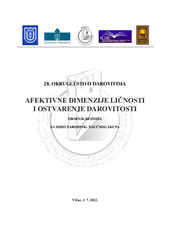Приказ основних података о документу
Kako daroviti adolescenti konceptualizuju kreativnost
How gifted adolescents conceptualize creativity
| dc.contributor | Gojkov, Grozdanka | |
| dc.contributor | Prtljaga, Snežana | |
| dc.creator | Maksić, Slavica | |
| dc.date.accessioned | 2022-07-06T10:57:14Z | |
| dc.date.available | 2022-07-06T10:57:14Z | |
| dc.date.issued | 2022 | |
| dc.identifier.isbn | 978-86-7372-298-6 | |
| dc.identifier.uri | http://ipir.ipisr.org.rs/handle/123456789/814 | |
| dc.description.abstract | Ispitivanje uverenja darovitih adolescenata o kreativnosti sprovedeno je u nameri da se bolje razume kako oni vide glavni cilj svoga razvoja. Učenici srednjih škola koji su pohađali vanškolske programe za darovite (N=337) popunili su Upitnik za ispitivanje implicitnih teorija kreativnosti. Analiziran je odgovor na otvoreno pitanje o tome šta čini kreativnost primenom tematske analize deduktivnog tipa, pri čemu su korišćene kategorije iz Modifikovanog 4P modela kreativnosti. Potom su izdvojeni najfrekventniji odgovori, koji su se odnosili na opise kreativnog procesa i kreativne osobe, na koje je primenjena tematska analiza induktivnog tipa. Rezultati su ukazali na značajno učešće afektivnih dimenzija u opisima kognitivnih, ekspresivnih i praktičnih procesa, kao i crta ličnosti, motivacije i sposobnosti, koji, prema uverenju adolescenata, čine kreativnost. Dobijena je kompleksna slika koja je uporediva sa naučnim teorijama kreativnosti i istaknute su njene praktične implikacije za podsticanje kreativnosti u školi. | sr |
| dc.description.abstract | The survey of gifted adolescents' beliefs about creativity was conducted in order to better understand how they see the main goal of their development. High school students who attended extracurricular programs for the gifted (N=337) completed the Implicit Theories of Creativity Questionnaire. The answer to the open question of what constitutes creativity was analyzed by applying thematic analysis of the deductive type, using categories from the Modified 4P model of creativity. Then, the most frequent answers were singled out, which refer to the descriptions of the creative process and the creative person, to which the thematic analysis of the inductive type was applied. The results indicated a significant participation of affective dimensions in the descriptions of cognitive, expressive and practical processes, as well as personality traits, motivation and abilities, which, according to adolescents, make creativity. A complex picture was obtained that is comparable to scientific theories of creativity, and its practical implications for encouraging creativity in school were highlighted. | sr |
| dc.language.iso | sr | sr |
| dc.language.iso | en | sr |
| dc.publisher | Vršac : Visoka škola strukovnih studija za vaspitače "Mihailo Palov" | sr |
| dc.rights | openAccess | sr |
| dc.source | Afektivne dimenzije ličnosti i ostvarenje darovitosti | sr |
| dc.subject | darovitost | sr |
| dc.subject | adolescenti | sr |
| dc.subject | implicitne teorije kreativnosti | sr |
| dc.subject | afekti | sr |
| dc.subject | giftedness | sr |
| dc.subject | adolescents | sr |
| dc.subject | implicit theories of creativity | sr |
| dc.subject | affects | sr |
| dc.title | Kako daroviti adolescenti konceptualizuju kreativnost | sr |
| dc.title | How gifted adolescents conceptualize creativity | sr |
| dc.type | conferenceObject | sr |
| dc.rights.license | ARR | sr |
| dc.citation.epage | 24 | |
| dc.citation.issue | 28 | |
| dc.citation.spage | 24 | |
| dc.description.other | Zbornik rezimea sa Međunarodnog naučnog skupa "Afektivne dimenzije ličnosti i ostvarenje darovitosti", Vršac, 1. 7. 2022. (Affective personality dimensions and giftedness fullfilment) | sr |
| dc.identifier.fulltext | http://ipir.ipisr.org.rs/bitstream/id/2483/Kako_daroviti_adolescenti_konceptualizuju_kreativnost_2022.pdf | |
| dc.identifier.rcub | https://hdl.handle.net/21.15107/rcub_ipir_814 | |
| dc.type.version | publishedVersion | sr |

